CHAPTER 22
Creating Sheet Metal Drawings
IN THIS CHAPTER
Working with flat patterns
Making special sheet metal drawing templates
After you have created your sheet metal models, you need to make drawings to get them manufactured. Fortunately, SolidWorks provides some nice tools to document, dimension, and annotate your parts in 2D.
Depending on whether your company does its own sheet metal manufacturing, you may or may not actually make flat pattern drawings. Many companies that use outside manufacturing for their sheet metal parts may just send them a drawing with views of a dimensioned part in the folded state. This is because it is the final formed dimensions that you want the shop to be responsible for, and if they use different flat dimensions to achieve that, it doesn't really matter.
Many users may think that providing a fully dimensioned flat pattern is a great value to the sheet metal shop. If your sheet metal shop is a professional outfit, they probably have their own software and their own way of doing things, in which case a flat pattern is redundant information and may cause more confusion than clarity.
On the other hand, if you are the sheet metal shop, or you specifically create drawings for the sheet metal shop, then creating the flat pattern is actually your business. This chapter will give you all the information you need to know to make sheet metal drawings, regardless of your role and without trying to tell you how to do your job.
Introducing Sheet Metal Drawings
Sheet metal drawings can take on various roles in your product development process — anything from general “make me a part that looks like this” to actually specifying how the work is to be done. Some drawings may need only the flat pattern, or only the formed part. Here I will assume that a sheet metal drawing will require both the formed and flat part, just to cover as much ground as possible.
If you need a drawing with both formed and flat geometry, you might consider making a two-page drawing — one page with the flat pattern and the other page with views of the 3D part. You might use one drawing sheet for the press operator and the other sheet for inspection. If you only need the flat pattern, you might consider using an isometric view of the part just for reference.
If your sheet metal parts are welded together with other sheet metal, structural, or plate parts, you might want to refer to the section later in this chapter on multi-body sheet metal drawings. You can accomplish the same things with an assembly (and in some cases the assembly will be the better option), but many people think that modeling in multi-bodies is easier. Sheet metal multi-body techniques are a little different, and in my opinion don't offer as many advantages as normal multi-body techniques. If you need to work in this mode, be careful to leave room on your drawing for exploded views and a weld list. Flat patterns require some extra thought if you have multiple sheet metal bodies in a single part.
You may also want to make a special drawing template for sheet metal drawings. The special template can contain custom blocks, title blocks, or table anchors.
Getting the Flat Pattern
When you need to make a drawing to build a sheet metal part from, getting the flat pattern is an essential part of the process. SolidWorks provides several ways to develop the flattened bend sections in the K-Factor, bend allowance, bend deduction, and bend calculation tables. Getting these values or equations correct is key in making the flat pattern the correct size to produce the finished part accurately. Chapter 21 covers how to use these methods, but you should obtain the actual values from your sheet metal shop.
You create the drawing of a sheet metal part in the same way that you would create one for any other type of part. You can use one of several methods, including the Create Drawing From Part command or dragging and dropping the part onto a drawing. Sheet metal drawings may serve different purposes. Usually a sheet metal drawing requires dimensioned orthogonal views of the finished part, and sometimes it also requires a flat pattern describing the blank the finished part is to be formed from.
To show a view of the flat pattern on a drawing where you already have a sheet metal part, select the view from the FeatureManager or the graphics window, and in the list of views below the Standard Views area of the Orientation panel of the PropertyManager, select Flat Pattern from the list. The Drawing View PropertyManager is shown in Figure 22.1.
FIGURE 22.1 Converting a view of a sheet metal part to a flat pattern
Understanding flat patterns and configurations
When a sheet metal part is put onto a drawing, SolidWorks automatically creates a derived configuration called SM-FLAT-PATTERN. The configuration doesn't exist until the part is put onto a drawing. For a part made with the Base Flange sheet metal method, this derived configuration in Figure 22.2 shows the default arrangement.
FIGURE 22.2 Automatically created derived configuration for the flat pattern

If your part already had multiple configurations, only the config that is showing on the drawing will get a derived flat pattern configuration. If you later show another configuration on the drawing, the derived flat pattern will not be automatically created until you show a flat pattern of that configuration.
Best Practice
You should be careful if you plan to make sheet metal parts with derived configurations for reasons other than the flat pattern. The automatic derived flat pattern configuration functionality may or may not be able to work with your manual or design table-driven derived configuration scheme.
Also be aware that there is a second way to get a flat pattern of a sheet metal part on the drawing. If you use the drop-down list in the Reference Configuration panel of the Drawing View PropertyManager, you can select the derived flat pattern configuration from there. The flat patterns that you get using these two methods may be oriented differently, and if you use the Flat Pattern selection from the More Views options, you will also get bend lines and annotations marking the direction, angle, and inside radius of the bend. The difference between the resulting views of these two methods is illustrated in Figure 22.3.
FIGURE 22.3 Comparing flat pattern views placed by using the More Views options, or by showing the derived flat pattern configuration
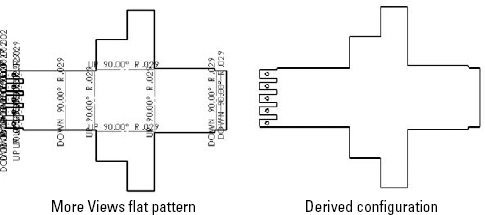
Showing bend lines and bend notes
If you show the derived configuration, the bend lines are not included in that view. To turn on the bend lines, you need to go to the FeatureManager for that view, scroll to the Flat Pattern feature, expand it, right-click the Bend Lines sketch, and select Show.
Figure 22.4 shows the drawing FeatureManager with the Bend Lines sketch highlighted.
To get the bend notes to show up, you need to use the Flat pattern view option shown in Figure 22.1. The bend notes are shown in Figure 22.5 and include which direction the bend is formed in, the angle of the bend, and the inside radius of the bend.
Other options for the display of bend notes are also available. Select Tools ![]() Options
Options ![]() Document Properties
Document Properties ![]() Sheet Metal
Sheet Metal ![]() Bend Notes
Bend Notes ![]() Style, and you can choose from the following options:
Style, and you can choose from the following options:
- Above bend line
- Below bend line
- With leader
When the notes are above or below the bend lines, they are aligned with the bend line, so the notes could be horizontal, vertical, or angled. If there is a succession of bends, interrupted in some way but close to one another, these notes can be on top of one another and difficult to read. This situation is shown in Figure 22.5.
FIGURE 22.4 Turning on the bend lines for a flat pattern view
FIGURE 22.5 Showing the bend notes for a flat pattern

If you use the With leader option, all notes are horizontal with respect to the drawing sheet, and a leader points to the bend line.
Showing the bounding box for the flat pattern
SolidWorks automatically calculates a bounding box for your sheet metal flat pattern. This is the smallest rectangle that the flat pattern will fit into. This can be useful if your manufacturing process cuts the flat pattern from individual blanks rather than a bigger sheet with nested flat patterns. Generally, the bigger sheet allows you greater material efficiency, but it may also be difficult to manage if you don't have the equipment, and it may be unnecessary if you are making low volumes of certain parts.
The bounding box may not be aligned the way you might expect, but it represents the smallest rectangle that SolidWorks calculates will include your flat pattern. Many shops have separate nesting software which may allow for custom fits or some additional options. If you are not sure if your shop would benefit from a bounding box on the drawing, you may want to ask them directly.
You can have some control over the bounding box. If you specify a grain direction in the Flat Pattern PropertyManager, the bounding box aligns with the grain direction. You can use an edge, axis, or sketch to define the grain direction. The grain direction is the pattern of streaks on the face of the sheet metal that indicates the direction the sheets were processed in fabrication. Sheet metal properties can vary somewhat if measured with and against the grain. Sometimes the grain is specified in a certain orientation for aesthetic reasons.
The bounding box is stored in the sheet metal part as a sketch, which you can see right below the Bend Lines sketch shown in Figure 22.4. You can show this sketch, and the drawing will display it as a construction line. Figure 22.6 shows a flat pattern with a bounding box.
FIGURE 22.6 Showing a bounding box on a drawing
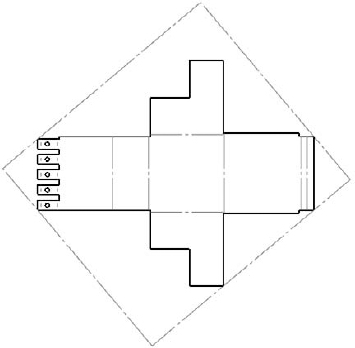
Showing bend areas on the part
If you want to show or hide the bend areas for all bends on the flattened part, open the part in its own window, and edit the Flat Pattern feature. You cannot edit the feature from the drawing; you have to do it from the part's own window. In the Flat-Pattern PropertyManager, make sure the Merge Faces option is turned off.
Figure 22.6 shows the bend lines (Merge Faces) turned off, and Figure 22.7 shows the bend lines (Merge Faces) turned on. Figure 22.7 also shows the setting which is available from the model. In Figure 22.7, the Tangent Edges are set to use a font. You can find this setting at View ![]() Display
Display ![]() Tangent Edges With Font.
Tangent Edges With Font.
FIGURE 22.7 Showing the tangent bend lines on a flat pattern

Making Drawings of Multi-Body Sheet Metal Parts
Multi-body sheet metal parts are still a bit of a curiosity in SolidWorks. You cannot flatten multiple sheet metal bodies simultaneously within a single sheet metal part. However, SolidWorks may be sending a confusing signal by adding more capabilities for drawings of multi-body parts. It is difficult to say what SolidWorks' intention was regarding multi-body sheet metal parts, but it is safe to say that you would do best to use them as a bridge to a single body, or when other parts such as small welded bits or PEM fasteners are pressed into a sheet metal part, creating an inseparable subassembly.
Figure 22.8 shows two different part scenarios that this chapter addresses. The part on the left is a simple sheet metal part with PEM standoffs from the SolidWorks Toolbox pressed into holes. The part on the right is a sheet metal part with multiple sheet metal parts and a simple plate, intended to be welded together. Both methods are valid uses of multi-body sheet metal parts.
FIGURE 22.8 Two multi-body sheet metal scenarios
Displaying bodies on the sheet metal drawing
SolidWorks allows you to hide bodies within a drawing view. To do this, click inside the view; at the top of the PropertyManager for the view in the Reference Configuration panel is a button labeled Select Bodies. Use this button to change the bodies that are visible in the drawing view. If you use the method of right-clicking a face of the body you want to hide, and choosing Show/Hide ![]() Hide Body, you may get yourself into a situation where the body is hidden in multiple views, and you may have difficulty regaining control over which bodies are shown in which views again. The Select Bodies button and the body selection list are shown in Figure 22.9.
Hide Body, you may get yourself into a situation where the body is hidden in multiple views, and you may have difficulty regaining control over which bodies are shown in which views again. The Select Bodies button and the body selection list are shown in Figure 22.9.
FIGURE 22.9 Selecting the bodies to show on the drawing

Caution
Use the Select Bodies button in the Reference Configurations panel of the View PropertyManager to hide bodies in views. If you use another method, you may not be able to control which bodies are shown in a particular view. Whether this is a bug or by design is unclear, but the functionality does not appear to be consistent.
Another thing to be careful of is that in SolidWorks 2011 SP 1, the new functionality that allows you to use the part color on the drawing does not apply to bodies. If you use this setting, all of the bodies will use the part color. If your part uses an appearance, a color is always part of the appearance assignment, although the part may not display the color. For example, a steel appearance may still have a blue color assigned. You will see the texture-like appearance when the part is shaded, but you will see the associated color when the part is shown in wireframe mode.
Using a cut list in a sheet metal part
When you create a new sheet metal part, the FeatureManager automatically gets a new item called a cut list. The cut list is technically called a “weldment cut list,” but it is used in sheet metal as well as in weldments to keep track of the parts modeled as bodies. The cut list is not very interesting until you have multiple pieces to list, and this only happens in a part file when you have multi-body parts. Beyond using multi-bodies as an interim condition where you're bridging between bodies, the cut list will be used when the final model is intended to have multiple bodies. The real use of the cut list is on the drawing for listing each of the individual pieces that go together to make the finished part. These pieces can be purchased hardware, other sheet metal parts, or welded plate parts, among others.
Cross-Reference
Weldments and Bills of Materials are covered in the SolidWorks 2011 Assemblies Bible (Wiley, 2011).
You can add several types of values to the cut list. It is essentially a Bill of Materials for welded assemblies. To access the interface for cut list properties, right-click a cut list item, and select Properties. Figure 22.10 shows a default cut list properties table.
FIGURE 22.10 Managing properties for a sheet metal cut list
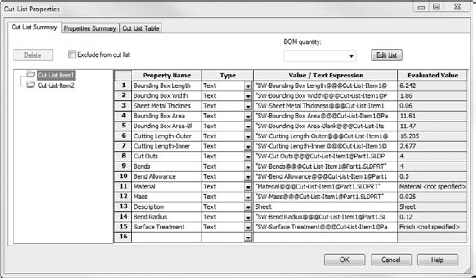
Managing cut list properties
To fill out the cut list properties, use the Cut List Summary the same way that you would use the Custom Properties data entry. Notice also that several properties already exist for the cut list. These include sheet metal–specific items like Bounding Box Length, Sheet Metal Thickness, the number of bends, material, or a special cut list–specific description. You can add additional custom properties as well.
Notice that on the left in Figure 22.10 is a list of all of the cut list items. This enables you to set the properties for each item. While most of the values use automated syntax, others, like the Description or any custom properties you might add, require manual data entry.
The next step after arranging all of your cut list properties is to create a drawing and add the cut list to a view. When you create a drawing of a multi-body sheet metal part, you can place the cut list on the drawing.
Placing the cut list on the drawing
Once you have created the multi-body sheet metal part, filled out the cut list properties, and created at least one drawing view of the part (flat or formed), you are ready to put a cut list on the drawing. I will assume you are placing a default cut list, and then need to create a customized one later. The next section will also go over how to create a cut list template once you have made one to suit your needs.
With the multi-body sheet metal drawing active, select Insert ![]() Tables
Tables ![]() Weldment Cut List. The Weldment Cut List PropertyManager is shown in Figure 22.11.
Weldment Cut List. The Weldment Cut List PropertyManager is shown in Figure 22.11.
FIGURE 22.11 Configuring a Weldment Cut List for a multi-body sheet metal part
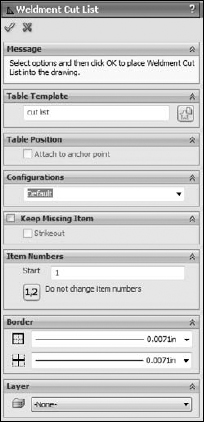
The first option in the Weldment Cut List PropertyManager is to select the template. By default, there is only the single sample table, which you will probably need to customize somewhat to suit your needs. You will do that shortly.
Once you have set the options to your satisfaction, place the cut list on the drawing by clicking where you want to place the table. Notice that as you drag the table around, it snaps to the drawing format border. You can place it at one of these snap locations or just place it in a blank area on the drawing.
The default cut list for a multi-body sheet metal part where the cut list properties have been filled out for each cut list item appears in Figure 22.12.
FIGURE 22.12 Placing the default cut list on the drawing

When you select a column header (labeled with a letter), a Column PropertyManager appears, along with a text formatting bar (which appears to have a display bug affecting its top bar). This is all shown in Figure 22.13.
FIGURE 22.13 Customizing the cut list column
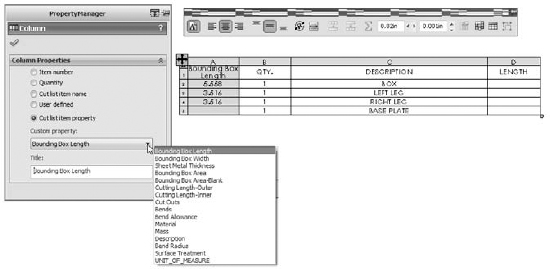
From here, you can change the information in the selected column. The first three column properties are built-in properties: Item Number, Quantity, and Description (cut list item name). The User Defined option lets you manually enter whatever text you want. The Cut List Item Property option allows you to select from a list of automated values, shown in Figure 22.13.
You can add additional columns by right-clicking a column and selecting Insert ![]() Column Right or Column Left. The additional columns can be formatted like the others.
Column Right or Column Left. The additional columns can be formatted like the others.
Saving a cut list template
Once you have customized the cut list the way you like it — with the automated or manual entry fields set up to save you time the next time you need to use a similar table — you can save the table as a template. Right-click the table and choose the Save As option. The file type that is assigned is *.sldwldtbt. This long file extension presumably stands for “weld table template.” While a weld table and a cut list are not necessarily the same thing, they do use the same templates. You will learn more about weldments in the SolidWorks 2011 Assemblies Bible (Wiley, 2011).
Save the template file in the location established for your weldment table templates. You can find this location at Tools ![]() Options
Options ![]() File Locations
File Locations ![]() Weldment Cut List Templates, which by default points to C:Program FilesSolidWorks CorpSolidWorkslangenglish, but you can (and should) keep all of your custom templates in a path that will not be overwritten by reinstalling or uninstalling the software, and that multiple users can share if necessary.
Weldment Cut List Templates, which by default points to C:Program FilesSolidWorks CorpSolidWorkslangenglish, but you can (and should) keep all of your custom templates in a path that will not be overwritten by reinstalling or uninstalling the software, and that multiple users can share if necessary.
The next time you need to use this template, you can select it using the Table Template drop-down list in the Weldment Cut List PropertyManager.
Summary
SolidWorks has a lot of special drawing functionality built around sheet metal parts. You may want to create a special template or format for sheet metal drawings, or even use multi-page drawings for including both flat and formed views of the part.
Multi-body modeling in sheet metal opens up another whole range of possibilities in documenting inseparable subassemblies and small weldments using sheet metal parts. The use of a cut list is similar to the use of a Bill of Materials, and though originally intended for weldments, it is also useful for sheet metal parts.



